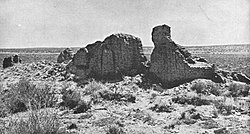Hawikuh Ruins
|
Hawikuh
|
|

Ruins of Mission La Purísima Concepción de Hawikuh, photo circa 1886
|
|
| Nearest city | Zuni, New Mexico |
|---|---|
| Coordinates | 34°56′25″N 108°59′57″W / 34.94028°N 108.99917°WCoordinates: 34°56′25″N 108°59′57″W / 34.94028°N 108.99917°W |
| Area | 10 acres (4.0 ha) |
| Built | 1539 |
| Part of | Zuni-Cibola Complex (#74002267) |
| NRHP Reference # | 66000502 |
| Significant dates | |
| Added to NRHP | October 15, 1966 |
| Designated NHL | October 9, 1960 |
| Designated NHLDCP | December 2, 1974 |
Hawikuh (Hawikku, "gum leaves" in Zuni) It was one of the largest of the Zuni pueblos at the time of the Spanish entrada. It was founded around 1400 AD. It was the first pueblo to be visited and conquered by Spanish explorers. The pueblo site is located 12 miles (19 km) southwest of Zuni Pueblo, on the Zuni Indian Reservation in Cibola County, New Mexico. The site was designated a National Historic Landmark as the Hawikuh Ruins in 1960, and is included as part of the Zuni-Cibola Complex of archaeological sites, a larger National Historic Landmark District designated in 1974.
Estevanico, a North African slave assigned to Fray Marcos de Niza's expedition, was the first non-native to visit Hawikuh, in 1539. He was killed when he unwittingly alarmed Zuni tribesmen with decorations that symbolized death.
Francisco Vásquez de Coronado conquered the pueblo in 1540, hoping it was one of the legendary "Seven Cities of Gold". He recorded its native name at the time as Cevola, though others who accompanied him wrote it as Cibola in their accounts. It has been conjectured that this name comes from a word meaning "buffalo". Coronado was severely disappointed by the lack of gold, but wrote that, "As far as I can tell, these Indians worship water, because it makes the corn grow and sustains their life." About the pueblo, he reported that,
Although they are not decorated with turquoises, nor made of lime or good bricks, nevertheless they are very good houses, with three, four, and five stories, where there are very good apartments... and some very good rooms underground Kivas, paved, which are made for winter and have something like hot baths.
...
Wikipedia


